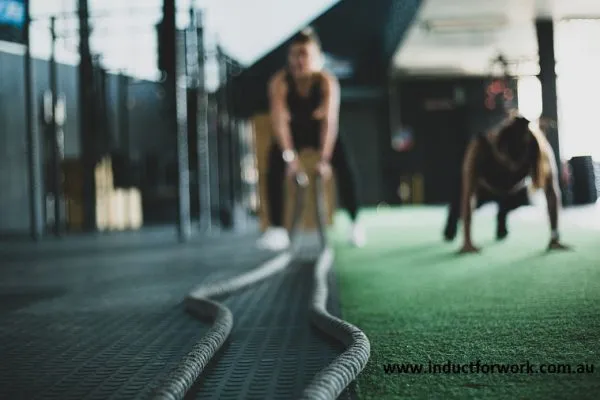LMS Training for Gyms
At the heart of any workout routine is the goal of leading a healthier and happier life. However exercise can be complicated and many people make mistakes without realizing it. While exercise should not cause pain or injury they are more common than most people think.
Injuries in the fitness industry happen often. Many statistics show that thousands of people worldwide are hospitalized each year due to sports-related injuries. Injuries at the gym are not just random accidents. They can be predicted and prevented.
As a gym owner you may be responsible if a client gets injured while exercising and negligence is found. Negligence does not just apply to the condition of equipment or facilities but also includes failing to give proper guidance and information. A gym owner may also be seen as negligent if they do not follow the required industry standards.
Types of Injuries Gym Owners Should Know About
here are three main types of injuries gym owners should be aware of and help members understand: acute chronic and overuse injuries.
Acute Injuries
Fractures sprains strains and tears are examples of acute injuries. These injuries happen suddenly and cause immediate pain or make it difficult to continue exercising. If a member experiences an acute injury encourage them to see a doctor for an X-ray. They may need immobilization materials or slings for recovery.
Chronic Injuries
Chronic injuries develop over time rather than happening instantly. Gym members may not even remember when the injury started. In these cases encourage gentle stretches rest and professional medical advice.
Overuse Injuries
Overuse injuries occur when a person puts too much stress on a certain body part for a long time. They often happen due to poor exercise techniques repetitive movements or lack of proper recovery time. If a gym member has an overuse injury suggest they take a break reduce workout intensity or apply ice before and after exercising.
Common Gym Injuries
Shoulder and Neck Injuries
Many people try to reduce neck tightness and improve posture after long hours at a desk. However neck and shoulder injuries often result from training too hard too soon or over-exercising without enough rest.
Treatment depends on severity. Small tears may need physical therapy or medication while severe cases like rotator cuff tears might require surgery.
Lower Back Injuries
Lower back strains and sprains often happen due to lifting too much weight improper technique or overuse. Most of the time these injuries heal on their own or with over-the-counter medication. However gym members should see a doctor if:
Pain lasts longer than a month
Pain affects walking or balance
Pain gets worse over time
Pain spreads to the legs
There are changes in bladder or bowel movements
Knee Injuries
Knee injuries often come from sedentary lifestyles or high-intensity workouts. Gym owners should design programs that strengthen muscles around the knees. To avoid knee injuries: ✔ Avoid deep squats where hips go lower than knees ✔ Be cautious when doing twisting motions ✔ Use proper technique when exercising
Foot and Ankle Injuries
To prevent foot and ankle injuries encourage gym members to:
✔ Wear properly cushioned shoes that support the arch
✔ Wear wicking socks to avoid blisters
✔ Maintain correct posture and equipment use to reduce strain

Causes of Gym Injuries
Understanding common causes of gym injuries can help gym owners prevent liability issues.
Overtraining
More exercise is not always better. Gym instructors should create customized workout plans based on individual needs. Along with exercising remind members to eat well stay hydrated and get enough sleep.
Poor Exercise Techniques
Incorrect weightlifting techniques can lead to muscle tears or joint damage. Make sure members:
✔ Use appropriate weights
✔ Avoid twisting while lifting
✔ Learn the correct form before trying new exercises
Inappropriate Exercise Programs
Not all exercises suit every person. For example:
✔ People with long thigh bones may struggle with squats
✔ Those with limited hip mobility may find deadlifts challenging
✔ Modifications like lifting from a raised position can make exercises safer
Encourage members to try different activities like yoga swimming or sports to reduce boredom and prevent injuries.
Lifting Too Much Weight
If a member has to jerk or struggle while lifting then the weight is too heavy. Advise them to lift within their physical ability.
Skipping Warm-Ups and Stretching
Warm-ups help increase blood flow to muscles and improve flexibility. Stretching before and after workouts can help prevent pain and injuries.
Wearing the Wrong Gear
Members should wear:
✔ Shoes with arch support and cushioned heels
✔ Non-restrictive breathable clothing
Ignoring Pain
Encourage members to stop exercising if they feel discomfort. They should seek medical help if pain does not improve.
Preventing Gym Injuries: What Gym Owners Should Do
Education
Gym owners should ensure:
✔ Trainers are properly certified and continuously trained
✔ Members receive guidance on correct techniques and injury prevention
✔ Staff stay updated on new equipment and safety guidelines
Safe Environment
✔ Equipment should be laid out to prevent overcrowding
✔ Floors should be clean dry and free from hazards
✔ Members should be informed about potential risks
Proper Equipment Maintenance
✔ Regularly check and repair or replace faulty equipment
✔ Clean machines and wipe down equipment after each use
Using Induct For Work for Gym Member and Instructor Training
The Induct For Work platform makes it easy for gym owners to educate staff and members on exercise safety. With Induct For Work gym owners can:
✔ Use customizable fitness industry templates for training
✔ Offer video courses for members and staff
✔ Provide certification programs for instructors
✔ Store important documents like work permits and licenses
✔ Upgrade existing training programs with new content
Why Use Induct For Work?
✔ Create virtual workout programs
✔ Train members before they arrive at the gym
✔ Offer customized safety inductions for different groups
✔ Keep records of training completion and policy acknowledgment
Induct For Work allows gyms to offer engaging training using visuals and audio ensuring members understand proper techniques before stepping into the gym.
Try Induct For Work for Free
Sign up for a 14-day free trial with no credit card required. After the trial period gyms can continue with our Free ‘Standard’ Plan or upgrade to Premium+ or Ultra packages.
By educating members maintaining a safe environment and using Induct For Work to streamline training gym owners can reduce injuries and provide a safer fitness experience for everyone.



